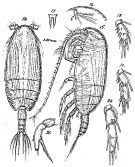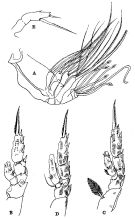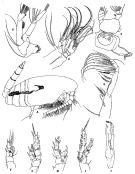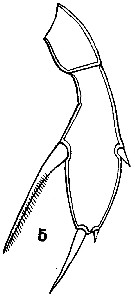|
|
 |
Fiche d'espèce de Copépode |
|
|
Calanoida ( Ordre ) |
|
|
|
Clausocalanoidea ( Superfamille ) |
|
|
|
Scolecitrichidae ( Famille ) |
|
|
|
Amallothrix ( Genre ) |
|
|
| |
Amallothrix arcuata (Sars, 1920) (F,M) | |
| | | | | | | Syn.: | Scolecithricella arcuata Sars, 1920 c (p.10); Sewell, 1948 (p.527, 530); Tanaka, 1962 (p.76, figs.F,M); Shih & Young, 1995 (p.73);
? Scolecithrix (Amallophora) robusta T. Scott, 1894 b (p.56);
(?) Scolecithricella pseudoarcuata Park, 1970 (p.511, Rem.); Roe, 1972 (p.277, tabl.1, tabl.2); Kovalev & Shmeleva, 1982 (p.84); Vives, 1982 (p.292);
Scolecithricella (Amallothrix) arcuata : Björnberg, 1973 (p.332, 384, 389) | | | | Ref.: | | | Sars, 1925 (p.185, Descr.F, figs.F); Sewell, 1929 (p.217); Jespersen, 1934 (p.90); no Wilson, 1942 a (p.171, figs.F); Sewell, 1947 (p.155, figs.F,M); C.B. Wilson, 1950 (p.159, figs.F); Bradford & al., 1983 (p.78, figs.F,M, Rem.); Vyshkvartzeva, 1999 (2000) (p.235); Vives Shmeleva, 2007 (p.722, figs.F,M, Rem.) |  issued from : J.M. Bradford, L. Haakonssen & J.B. Jillett in Mem. N.Z. Oceanogr. Inst., 1983, 90. [p.79, Fig.43]. Female: A, habitus (lateral left side); B, endopod of P2; C, P5; Nota: The south-west Pacific specimens have an extra small spinule on the posterior surface of P2 endopod 2 compared to Sars' (1925) illustration. Some variation in the female P5 has been noted.
|
 Issued from : G.O. Sars in Résult. Camp. Scient. Prince Albert I, 69, pls.1-127 (1924). [Pl.LI, figs.14-21]. As Scolecithrix arcuata. Female (from W Scotland): 14, habitus (dorsal); 15, idem (lateral left side); 16, forehead (lateral); 17, rostrum; 18, endopodal segments of P2; 19, endopodal segments of P3; 20, endopodal segments of P4; 21, P5. Nota Female: - Head and 1st pegigerous segment fused, 4th and 5th pediger segments fused. - Posterolateral corners of last thoracic segment short and rounded, slightly posteriorly obtuse. - Rostrum splitted up to base like 2 narrow points, each with a little thread at the apex. - Urosome equal about 1/3 length of the prosome; - Genital segment as long as the two succeeding segments together, slightly swollen ventrally. - Caudal rami short and barely divergent. - A1 reaching about the anal segment. - Swimming legs of the same structure than those Amallothrix lobata (= Falsilandrumius lobatus) , except the number and arrangement of spinules on the posterior surface of rami. - P5 with the distal segment curved and barely widdened. The inner spine more stronger, the length equal to the distal segmen; the external tooth located at the opposite to the inner spine.
|
 issued from : R.B.S. Sewell in The John Murray Expedition, 1933-34, Scientific Reports, VIII (1), 1947. [p.156, Fig.40]. Female (from Central part of Arabian Sea): A, Mx2; B, P2; C, P3; D, P4; E, P5. Nota: The proportional lengths of the various segments of the body (cephalon to caudal rami) as 492:98:97:90:85:42:42:18:36 = 1000. Head and 1st pediger segment fused, 4th and 5th fused. Genital segment equal in length to the two following segments, and slightly prominent ventrally. A123-segmented (segments 8-9 and 24-25 fused) reaches back to about the 4th urosomal segment. The number of setae from the various parts of Mx1: outer lobe (9); inner lobe 1 (11), inner lobe 2 (2), inner lobe 3 (3); basal segment 2 (4); endopod (7); exopod (9).
|
 issued from : R.B.S. Sewell in The John Murray Expedition, 1933-34, Scientific Reports, VIII (1), 1947. [p.157, Fig.41]. Male: A, habitus (dorso-lateral right side); B, A2; C, Md; D, Mx2; E, Mxp; F, P1; G, P2; H, basal segments and endopod of P3; I, P4; J, P5. Nota: The proportional lengths of the various segments of the body (cephalon to caudal rami) as 512:54:54:54:38:120:65:65:16:22 = 1000. Head and 1st pediger segment fused, 4th and 5th fused (a fine line of fusion runs close to the posterior margin. In A2 the exopod is considerably longer than the endopod. Exopodal segment 1 armed with cattered hair-like spinules; 1st basal segment bears a row of hairs on its inner aspect. The Md is well developed, between the basal part of the biting blade and the inflated segment bearing the two rami there is a small but fully chiyinized segment, which supports the contention that there are 3 segments in the basal part of this appendage. Mx1 identical with that of the female. Mx2 also very similar to that of the female. Mxp fully developed, and resembles with those of the female. The swimming legs (P1 to P4) show a close agreement with those of the female, even to the number and arrangement of the spinules on the various segments of the rami.
|
 issued from : C.B. Wilson in Scientific Results of Cruise VII of the Carnegie during 1928-1929. Biology-I. Carnegie Inst. Wash. Publ. 536, 1942. [p.219, Fig.5]. Female (Pacific: end of the Panama Canal): 5, P5. Nota: Strong curve of the frontal margin in lateral view.
| | | | | Ref. compl.: | | | Sewell, 1948 (p.330, 502, 521); Grice & Hulsemann, 1967 (p.16); Björnberg, 1973 (p.384); Harding, 1974 (p.141, tab. 3, gut contents); Vives, 1982 (p.292); Gopalakrishnan & Balachandran, 1992 (p.167, fig.7, Table 1, 2); Padmavati & al., 1998 (p.347); Kuriyama & Nishida, 2006 (p.299: Tab.II, p.309:Tab. III, fig.7, 10, vertical distribution); Gaard & al., 2008 (p.59, Table 1, N Mid-Atlantic Ridge) | | | | NZ: | 10 + 2 douteuses | | |
|
Carte de distribution de Amallothrix arcuata par zones géographiques
|
| | | | | | | | | | | | | Loc: | | | (?) G. of Guinea, (?) Canary Is., (?) off Morocco-Mauritania, off Madeira, off Portugal, (?) G. of Mexico, (?) Sargasso Sea, off E Cape Cod, Davis Strait, W Ireland, W Scotland, W Medit. W (? Baleares Sea), E Medit. (Ionian-Cyprus), Mer Arabian Sea, off S Laccadive Is., Indian, China Seas (South China Sea), Japan, Sagami Bay, New Zealand, off E Malpelo Is., Galapagos, Peru, N Chile. | | | | N: | 17 | | | | Lg.: | | | (1) F: 2,8; (9) F: 2,8-2,6; (11) F: 2,5; M: 3; (117) F: 2,49; M: 2,94; (1000) F: 2,4 ± 0,2; M: 3,1 ± 0,1; {F: 2,20-2,80; M: 2,94-3,20} | | | | Rem.: | méso-bathypélagique.
Pour Sars (1925, p.186) cette espèce peut être facilement distinguée par la forme bombée singulière de la partie céphalique, particulièrement archée.
Les localisations suivi par (?) correspondent à la synonymie avec Amallothrix pseudoarcuata si celle-ci doit être retenue comme l’estiment Bradford & al. (1983). Vives & Shmeleva (2007, p.722) distinguent les deux espèces.
Voir aussi les remarques en anglais | | | Dernière mise à jour : 19/01/2021 | |
|
|
 Toute utilisation de ce site pour une publication sera mentionnée avec la référence suivante : Toute utilisation de ce site pour une publication sera mentionnée avec la référence suivante :
Razouls C., Desreumaux N., Kouwenberg J. et de Bovée F., 2005-2024. - Biodiversité des Copépodes planctoniques marins (morphologie, répartition géographique et données biologiques). Sorbonne Université, CNRS. Disponible sur http://copepodes.obs-banyuls.fr [Accédé le 19 avril 2024] © copyright 2005-2024 Sorbonne Université, CNRS
|
|
 |
 |








